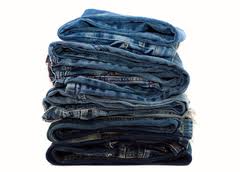The textile supply chain and jeans production in China
 The video (in German language) shows the manufacturing of jeans made for well known brands in Guangdong province of China. It was broadcasted on the German television channel Phoenix just a few days ago.
The video (in German language) shows the manufacturing of jeans made for well known brands in Guangdong province of China. It was broadcasted on the German television channel Phoenix just a few days ago.
One particular example was kik, a German discount retailer. Kik´s retail selling price in Germany for a pair of jeans is 9.99 €. The journalists tracked down the origin of the jeans to a manufacturer in Guangdong in China and found out that the manufacturer in China sells a pair of jeans for roughly 3 € to a trader.
The video shows critical issues of poor safely standards in working conditions and environmental pollution for dyeing and finishing, for example bleaching with hypochlorite by manual spray applications in the basement of a Chinese factory shop. The deeply coloured effluent on the video does not really look like state of the art in effluent treatment either.
To read the full article, please login. The full content of this article and all premium articles is available exclusively for site members.
Site membership is free. If you are an existing user, please login. New users may register below.



